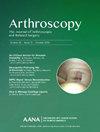尽管相关性很强,但基于 MR 和 CT 的股骨大小测量仍存在差异
IF 4.4
1区 医学
Q1 ORTHOPEDICS
Arthroscopy-The Journal of Arthroscopic and Related Surgery
Pub Date : 2024-09-01
DOI:10.1016/j.arthro.2023.12.025
引用次数: 0
摘要
方法对股骨髋臼撞击症(FAI)患者进行回顾性研究,这些患者术前接受了手术髋关节和同侧股骨远端 CT 和 MR 成像评估。采用墨菲法、斜面法、Reikerås法和Lee法测量股骨长度。计算了评分者内部和评分者之间的一致性。对使用不同成像模式和测量方法进行的测量结果进行了线性回归和Bland-Altman分析。根据样本人群中的百分位数,将下四分位数、中间两个四分位数和上四分位数内的股骨版测量值分为不同的组别。结果53名患者(39.4 ± 9.1岁;32名女性)被纳入分析范围。所有模式和方法的评分者内部和评分者之间的可靠性都很高(评分者内部 ICC 范围为 0.963-0.993;评分者之间 ICC 范围为 0.871-0.960)。在所有方法中,基于 MR 和 CT 的股骨版本测量都显示出很强的相关性,其中 Lee 方法显示出最强的相关性(r = 0.904),而斜向方法显示出最低的相关性(r = 0.684)(所有 P < .001)。基于 MR 的测量结果小于基于 CT 的测量结果,平均差异为 4.5° 至 10.3°。MR和CT之间的分类一致性从51%到74%不等,而不同测量方法之间的一致性从68%到85%不等。不同测量模式之间的分类一致性为中度到高度一致。不同方法之间的测量结果显示出较强的相关性和较高的一致性。本文章由计算机程序翻译,如有差异,请以英文原文为准。
Discrepancies in Magnetic Resonance– and Computed Tomography–Based Femoral Version Measurements Despite Strong Correlations
Purpose
To determine the correlation and classification consistency of femoral version measurements between magnetic resonance (MR) and computed tomography (CT) using 4 commonly used measurement methods.
Methods
A retrospective study was performed on patients with femoroacetabular impingement (FAI) who received preoperative CT and MR imaging assessment of the surgical hip and ipsilateral distal femur. Femoral version was measured using the Murphy method, the oblique method, the Reikerås method, and the Lee method. Intra- and inter-rater agreements were calculated. Linear regression and Bland-Altman analysis were performed for measurements using different imaging modalities and measurement methods. Femoral version measurements within the lower quartile, the middle 2 quartiles, and the upper quartile were classified into different groups based on their percentile within the sample population. Classification consistency rates between modalities and methods were calculated and compared.
Results
Fifty-three patients (39.4 ± 9.1 years; 32 female) were included for analysis. Intra- and inter-rater reliability were high for all modalities and methods (intrarater intraclass correlation coefficient [ICC] range, 0.963-0.993; inter-rater ICC range, 0.871-0.960). MR- and CT-based femoral version measurements showed strong correlations for all methods, with the Lee method demonstrating the strongest association (r = 0.904), while the oblique method exhibited the lowest correlation (r = 0.684) (all P < .001). MR-based measurements were smaller than CT-based measurements, with mean differences ranging from 4.5° to 10.3°. Classification consistency between MR and CT ranged from 51% to 74%, whereas the consistency between different measurement methods ranged from 68% to 85%.
Conclusions
While strong correlations were observed between MR- and CT-based femoral version measurements, MR-based measurements were significantly smaller than their CT counterparts. Classification consistency between the modalities was moderate to high. Measurements between different methods showed strong correlations with high consistency rates.
Level of Evidence
Level III, retrospective case series.
求助全文
通过发布文献求助,成功后即可免费获取论文全文。
去求助
来源期刊
CiteScore
9.30
自引率
17.00%
发文量
555
审稿时长
58 days
期刊介绍:
Nowhere is minimally invasive surgery explained better than in Arthroscopy, the leading peer-reviewed journal in the field. Every issue enables you to put into perspective the usefulness of the various emerging arthroscopic techniques. The advantages and disadvantages of these methods -- along with their applications in various situations -- are discussed in relation to their efficiency, efficacy and cost benefit. As a special incentive, paid subscribers also receive access to the journal expanded website.

 求助内容:
求助内容: 应助结果提醒方式:
应助结果提醒方式:


